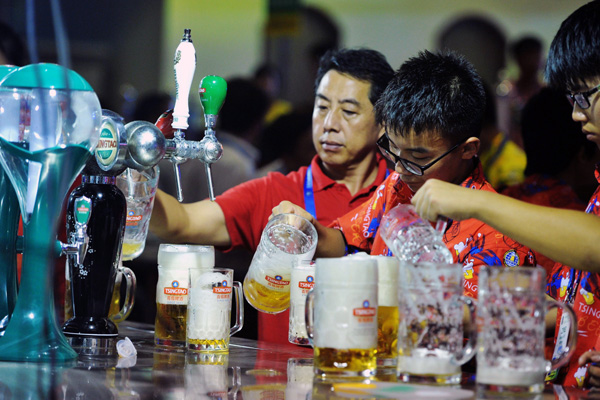 |
|
Chinese consumers enjoy drinks during a beer festival in Qingdao, Shandong province. Along with the swelling demand for high-end beer in China, investments in the craft beer segment have been rising in recent years. [Photo provided to China Daily] |
One hot Saturday afternoon mid-September, Li Hao, a 29-year-old researcher with a chemical company in Shanghai, binged on a dozen varieties of craft beer. He helped himself to all those drinks at a beer fair at Pudong Kerry Center in Shanghai. More than 50 stalls were selling hundreds of brands, both global and local. Li wished he had a pair of bellies to take them all in.
"I had never imagined beer-drinking could produce varied experiences of tastes wildly different from one another. Until now, beer was just an economical refresher for me, particularly on scorching summer days. All those cans and bottles of different brands tasted the same more or less. But craft beer-phew, it's different, and like wines now ... high-end beverages, with qualities that match their high price," Li said.
In Shanghai these days, consumers can buy more than 200 varieties of craft beer at high-end groceries, brewery-run outlets, boutique dining bars or through home-delivery services. Prices range between 30 yuan ($4.5) and 100 yuan per liter.
Investors are eyeing the craft beer market as segment expansion appears on the horizon and demand for niche products rises, said experts.
According to Wang Deliang, brewery research director with the China National Research Institute of Food & Fermentation Industries, investments in the craft beer segment have been rising in recent years because of prospects of high profits of up to 30 percent.
Investments need not be high as in other liquor segments like whisky because craft beer, a niche product, is not produced on a mass scale, said Wang.
Take Beijing-based Panda Brew that started in 2013. It has so far received 20 million yuan from a handful of investors, including venture capital firm Tiantu Capital. Its capacity has increased to annual output of some 1,000 metric tons, which is supplied to 50 cities across China.
Seeing such market potential, large brewers are jumping on the craft beer bandwagon. Earlier this year, Guangzhou Zhujiang Brewery Group Co Ltd announced it will launch four facilities to produce craft beer and use online distribution channels to sell it.
Investments in consumption-driven sectors, particularly high-end food and beverages, picked up in recent years because consumers have been upwardly mobile. Supply-side reforms have also helped improve operational efficiencies, improving prospects for profits. An increasing number of consumers have been exposed to a wider range of choices due to travel for work, tourism or education, thus creating demand for new products in the domestic market.
The fizz in the craft beer market reflects consumers' rising individualism and assertiveness with regard to preferences. As the market opens up, more and more imported beer brands, particularly craft beer labels, have increased their offerings in China, according to a research note from consultancy Roland Berger.
While the traditional beer market in China is highly consolidated and dominated by a handful of players, the craft beer brewery market is highly segmented. According to data of Dianping Holdings, China's biggest online food service ratings website and a key information provider, China has more than 3,000 craft beer breweries. Their output and sales revenue are less than 3 percent of the entire beer market.
In the US, craft beer takes about 13 percent of the market share, according to an estimate in a research note of Founders Securities.
Unlike the mild-tasting canned and bottled beer, which is distributed through supermarkets under the big players' brands, craft beer usually has a stronger taste, a result of high-gravity brewing. Each variety of craft beer has a distinct taste as the raw materials used, brewing conditions, techniques, and brewers' flavors vary. Output is usually to the tune of just 1,000 liters per day.
"Limited supply, unique flavors, distinct experience and high-end branding all appeal to the younger generation of consumers who like to have something different," said Michael To, marketing specialist with Shanghai-based Focus Strategy Consultancy Ltd.
Shi Dechuan, a 34-year-old software programmer based in Shanghai, said craft beer made by a local brewery along the road to Yunnan province was most impressive. He discovered the beer while traveling in summer this year.
"You don't really want to drink the same beer when you travel to different places, so craft beer, which uses local fruits, tea leaves, malt and yeast, gives you that sense of locality, and makes a tour different," said Shi.

